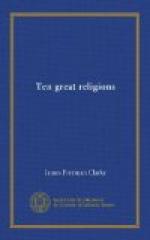The Ayrans, long before the age of the Vedas or the Zend Avesta, were living as a pastoral people on the great plains east of the Caspian Sea. What their condition was at that epoch is deduced by the following method: If it is found that the name of any fact is the same in two or more of the seven tribal languages of this stock, it is evident that the name was given to it before they separated. For there is no reason to suppose that two nations living wide apart would have independently selected the same word for the same object. For example, since we find that house is in Sanskrit Damn and Dam; in Zend, Demana; in Greek, [Greek: Domos]; in Latin, Domus; in Irish, Dahm; in Slavonic, Domu,—from which root comes also our English word Domestic,—we may be pretty sure that the original Aryans lived in houses. When we learn that boat was in Sanskrit Nau or nauka; in Persian, Naw, nawah; in Greek, [Greek: Naus]; in Latin, Navis; in old Irish, Noi or nai; in old German, Nawa or nawi; and in Polish Nawa, we cannot doubt that they knew something of what we call in English Nautical affairs, or Navigation. But as the words designating masts, sails, yards, &c. differ wholly from each other in all these linguistic families, it is reasonable to infer that the Aryans, before their dispersion, went only in boats, with oars, on the rivers of their land, the Oxus and Jaxartes, and did not sail anywhere on the sea.
Pursuing this method, we see that we can ask almost any question concerning the condition of the Aryans, and obtain an answer by means of Comparative Philology.
Were they a pastoral people? The very word pastoral gives us the answer. For Pa in Sanskrit means to watch, to guard, as men guard cattle,—from which a whole company of words has come in all the Aryan languages.
The results of this method of inquiry, so far as given by Pictet, are these. Some 3000 years B.C.,[33] the Aryans, as yet undivided into Hindoos, Persians, Kelts, Latins, Greeks, Teutons, and Slavi, were living in Central Asia, in a region of which Bactriana was the centre. Here they must have remained long enough to have developed their admirable language, the mother-tongue of those which we know. They were essentially a pastoral, but not a nomad people, having fixed homes. They had oxen, horses, sheep, goats, hogs, and domestic fowls. Herds of cows fed in pastures, each the property of a community, and each with a cluster of stables in the centre. The daughters[34] of the house were the dairy-maids; the food was chiefly the products of the dairy and the flesh of the cattle. The cow was, however, the most important animal, and gave its name to many plants, and even to the clouds and stars, in which men saw heavenly herds passing over the firmament above them.




